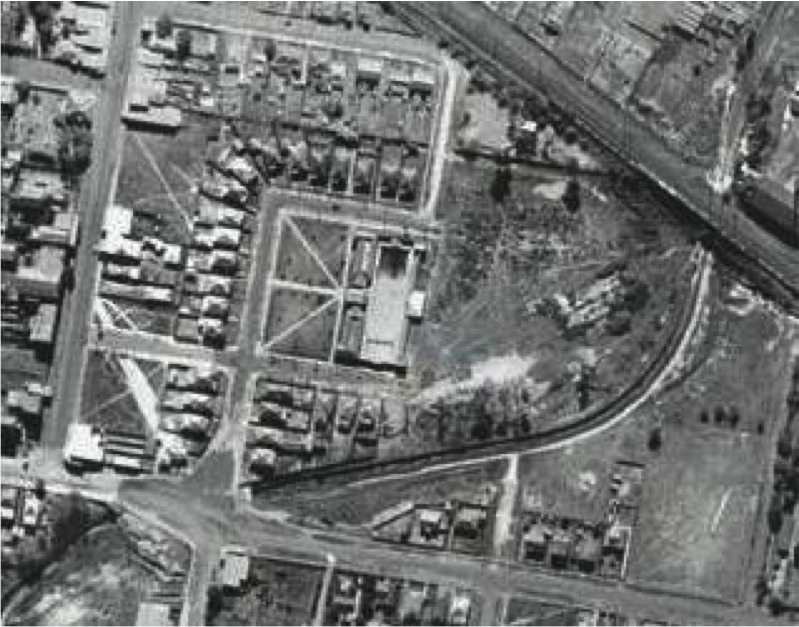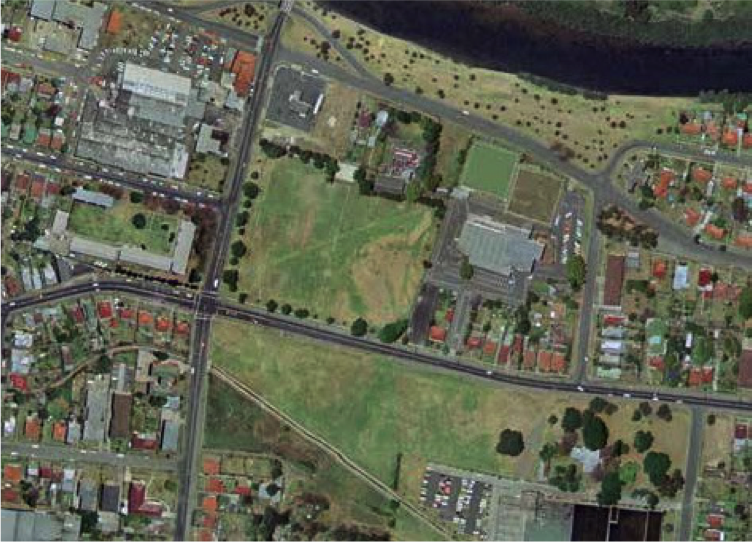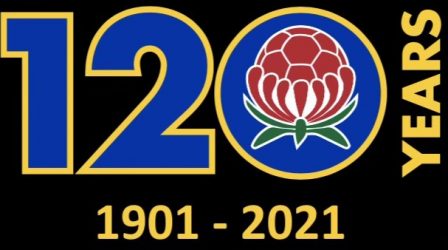CLUB HISTORY AND NAME
On Saturday afternoon 14 August 1880, a small but inquisitive crowd pressing the touchlines watched twenty two players trot onto Parramatta Common to play a round ball game. Eleven of them were in the colours of the King’s School: they were members of the school’s first XV rugby side. The other players were dressed in blue stockings, knickerbockers that billowed beneath the knee, and white jerseys that sported a southern cross over the left breast. Their name was shortly to become ‘The Wanderers’, and this match is generally accepted as the first match of English rules Football in Australia – and it happened in our back yard!
Soon there would be other teams but it was in the Granville Clyde area that is recognized as the cradle of the game. In 1882 the powerhouse Granville Magpies were formed and they recruited many players from the local factories, especially the Scottish lads from Hudson Bros Engineering, later called Clyde Engineering. By the late 1890s the Magpies were no longer a powerhouse and there was a genuine concern for the game in the district.
Inspired by an informal school’s competition playing in Balmain and the need to produce more and better players, in 1900 there were several local businessman and former soccer players affectionately called the Granville “old timers” who were keen to improve the growth of the game in the Granville District. One true gentlemen and visionary was Frederick William Barlow, who was especially responsible for the founding of the GDSFA.
Frederick Barlow, himself a former Granville Magpie player, advertised in the local newspaper, for a Public Meeting “of patrons and supporters of the game…and take steps to form an Association” to be held at the Granville School of Arts on 16 May 1900. In the same publication was a supporting article detailing how he proposed to inaugurate the “the pure game of football” into the local public schools and that he would arrange for the supply of soccer footballs, organise fields and goalposts and provide 11 silver medals for the champion team and 1 gold medal for the manager of the team.
After the 1900 competition was deemed a big success, the fledgling Association now had plans to grow its own competitions. Whilst the first year competition was only for schools, in 1901, community teams and clubs were being formed to play in 3 grades of competitions. The A Grade would remain for the under 14 year old school teams. The B Grade for ages between 14 and 16 ½ and the C Grade for over 16 year olds.
IN 1901 OUR CLUB WAS BORN WHEN WE ENTERED A TEAM IN THE B GRADE COMPETITION! We are the oldest club in the oldest Association in Australia! In our first year, we started the season with a couple of good wins but then struggled to win only a few more and failed to make the finals.
So can we claim to be an Association Foundation club member? Perhaps but it is a technical discussion.
Note that for much of our early history, we were simply referred to as the “Waratahs”, however being from north of the rail lines the, in first few years the newspapers also called us “those Parramattans”, “Harris Park Waratah” and even “Pitt Row Waratah”. For decades we did not have a “home ground” and played in many locations.
Unfortunately no other clubs exist from these early days, in fact the second oldest club in the GDSFA is the Granville Kewpies who can accurately define and trace its club history to its inception, being in 1919. We have a wonderful rivalry with the Kewpies and it is the oldest soccer Derby in Australia – more than a century old! Traditionally we claim the territory north of the railway lines and the Kewpies claim the south.
The Kewpies can also claim to being a club operating continuously every year since its inception. Whilst we are the oldest club in Western Sydney, unfortunately we cannot make this same claim because there were some years where we did not field a team, most notably during WWI.
With the assistance of researching old local newspapers, mostly the Cumberland Argus and Fruitgrowers Advocate, digitally on line from the National Library of Australia, it has been very interesting to learn that there was a Granville Waratah Rugby Union Club playing between 1898 and 1902. While excited with the prospects that we are one in the same and that we are even older, after extensive research, unfortunately we have found no evidence, no link for us to make that claim….at least not yet.
Over the decades the Mighty Waratah club has enjoyed many successes at both junior and senior levels with the golden period coming between 1965 and 1973 when the All-conquering All-Age Mens Senior Division 1 team won the Challenge Shield (which is the oldest Soccer Shield still in use in Australia since 1901) 8 out of 9 years and the Cottam Cup (which is the oldest Soccer knock out competition in Australia since 1907) for 7 consecutive years. We hold the mantle of having won the prestigious Cottam Cup more than any other club with 12 titles. Note that there is possibly a 13th title in the early 1950’s that has not been recorded but we are still investigating.
In 1973 our Under 21’s won the Champion of Champions and in 1980 our Under 18’s also were crowned state Champion of Champions.
Aside from the many local trophies and awards, the club has produced 3 SOCCEROOS:
- BILL HENDERSON played for the club in the mid 1940’s. His under 16 year old team won the competition in 1946 and his team photograph and the trophy are displayed in the clubhouse. Bill played for Australia in the mid 1950’s and was Australia’s first Olyroo as he was the goal keeper for Australia at the 1956 Melbourne Olympics.
Read this wonderful and richly historical interview from 2008 with Bill and his brother Andy discussing their soccer football careers starting as boys in Granville.
Some great history and photos of Bill are here.
- KENNY VAIRY played for the club and with Bill Henderson in the champion 1946 team and played with Bill (and other Granville players) as inside left striker for Australia in 1955 against South Africa.
Read this excellent interview from 2008 with Kenny discussing his soccer football career
**Bill and Kenny were part of a dynasty of Granville players that dominated the Australian team in the 1950’s. Players from the Granville Kewpies and Waratah clubs fed the mighty Granville Magpie club for decades.
- MARK JANKOVIC played one season with our under 14’s in 1973. He played for Australia as a striker in the early to mid 1980’s.
Hey – you’re in Parramatta not Granville – whats with the Name?
Being 300 meters from the heart of Parramatta, this is a good question.
In the early years, the club played out of many different grounds in the Granville area including, Granville Park, Merrylands, Pitt Row (which includes Ollie Webb Reserve and Jones Park) Parramatta and A’Beckett Street Park, Granville (lost due to the M4 motorway) and even Parramatta Park but by the 1940’s mostly settled for Brunton Park (affectionately known to locals as Brunton’s Paddock), located on the corner of Clyde and William Streets Granville. The park was named after Brunton’s Flour Mill which was demolished after WWII. The park is now the site of the Granville RSL club who purchased the land in 1960.

When construction of the RSL club commenced in the early 1960’s, we moved to James Ruse Reserve, which is the park land to the immediate west of Hambledon Cottage however when Parkes Street was extended to link with Hassall Street in the late 1970’s, it dissected James Ruse Reserve and we were forced to move north across the road to Robin Thomas Reserve. Interestingly, just a few years earlier field number 2 was a land fill dump that was leveled and grassed. It has been our home ever since.

There have seen several pushes to change the club’s name through the years, the most recent in 2015. Over 150 members attended this meeting and the motion failed by a very large margin – it is clear our members proudly want to retain the name and all its glorious history (first you get used to the name and then you fall in love with it).
As the Granville area was arguably the birth place of soccer football in Australia and certainly then the cradle of the game for decades, it makes no sense to change the name and severe that proud and unbroken connection.
(Updated FEB 2021 – more detail about the start up of the association)
